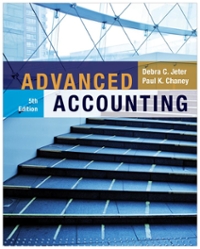Question
Financial statements 1. How might users of IAS 1 apply the information provided in the presentation of IFRS financial statements? a. To make economic decisions
1. How might users of IAS 1 apply the information provided in the presentation of IFRS financial statements?
a. To make economic decisions regarding the companys financial position, financial performance, and cash flows.
b. To make economic decisions regarding the companys financial performance, cash flows, and hiring guidelines.
c. To make economic decisions regarding the companys cash flows, hiring guidelines, and environmental position.
d. To make economic decisions regarding the companys financial performance, environmental position, and community service.
2. What would be included in a complete set of IFRS financial statements?
a. A balance sheet, statement of comprehensive income, a statement of changes in equity and statement of cash flows.
b. A balance sheet, statement of comprehensive income, a statement of changes in equity, statement of cash flows and notes comprising a summary of significant accounting policies and other explanatory notes.
c. A balance sheet, statement of comprehensive income, a statement of changes in equity, statement of cash flows, financial review by management and notes comprising a summary of significant accounting policies and other explanatory notes.
d. A balance sheet, statement of comprehensive income, a statement of changes in equity, statement of cash flows, financial review by management, value-added statements and notes comprising a summary of significant accounting policies and other explanatory notes.
3. Both US GAAP and IFRS frameworks require financial statements (except the statement of cash flows) to be prepared on an accrual basis except for rare circumstances.
a. True
b. False
IFRS requires comparative information to be disclosed with respect to the previous period for all amounts presented in the financial statements. Whether true or false, briefly explain how this compares to US GAAP and SEC requirements.
a. True
b. False
When is a presentation of assets and liabilities in the order of their liquidity allowed under IFRS? Briefly explain how this compares to US GAAP.
a. When such presentation is done before the interim financial statements are issued.
b. When such presentation allows the company to measure assets against liabilities.
c. When such presentation provides working capital distinctions.
d. When such presentation provides more relevant and reliable information.
IAS 1 prescribes the order or format in which items are to be presented in the balance sheet.
a. True
b. False
7. Using IFRS, deferred tax assets and liabilities may be classified as:
a. Only non-current.
b. Only current.
c. Current or non-current based on the nature of the related asset or liability.
8. A company reports using IFRS. The company violates its debt covenants before fiscal year-end. The lender decides to waive the debt covenant violation that would have resulted in the debt being due within 12 months rather than 18 months. When must the lender waive the violation for the company to keep the debt as non-current on the fiscal year-end balance sheet? Briefly explain how this compares to US GAAP.
a. By the end of the fiscal year.
b. After fiscal year end but prior to the issuance of the financial statements.
c. Both a. and b. are correct.
9. IAS 1 requires a choice between two expense classifications based on which is reliable and more relevant. What are these expense classifications?
a. By the nature of the expense and by the function of the expense.
b. By the function of the expense and by the cost of the expense.
c. By the nature of the expense and the duration of the expense.
d. By the cost of the expense and the duration of the expense.
10. IFRS identifies items of income and expense that are required by other standards or interpretations to be recognized directly into equity as:
a. Transition reserves.
b. Other reserves.
c. Accumulated other comprehensive income.
11. Using IFRS, companies classify interest and dividends paid or received as:
a. Operating cash flows.
b. Interest and dividends paid as financing cash flows and interest and dividends received as investing cash flows.
c. Interest received and paid and dividends received classified as operating cash flows and dividends paid as financing cash flows.
d. a. or b.
12. Using US GAAP, companies classify interest and dividends paid or received as:
a. Operating cash flows.
b. Interest and dividends paid as financing cash flows and interest and dividends received as investing cash flows.
c. Interest received and paid and dividends received classified as operating cash flows and dividends paid as financing cash flows.
d. a. or b.
13. Using IFRS, overdrafts may be classified as a component of cash and cash equivalents if considered to be an integral part of an enterprises cash management. Explain how this differs from US GAAP.
a. True
b. False
14. IFRS does not require the presentation of items in OCI that ultimately may be reclassified into net income to be presented separately from those that will not be reclassified into net income.
True
False
Step by Step Solution
There are 3 Steps involved in it
Step: 1

Get Instant Access to Expert-Tailored Solutions
See step-by-step solutions with expert insights and AI powered tools for academic success
Step: 2

Step: 3

Ace Your Homework with AI
Get the answers you need in no time with our AI-driven, step-by-step assistance
Get Started


